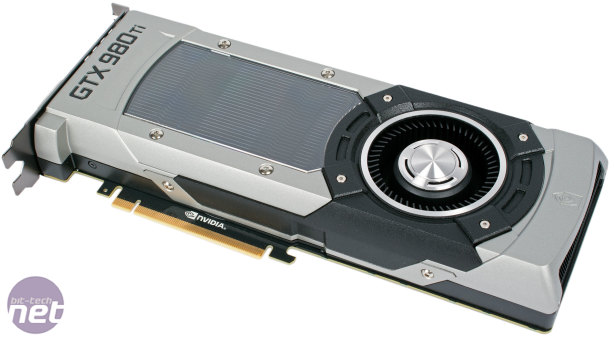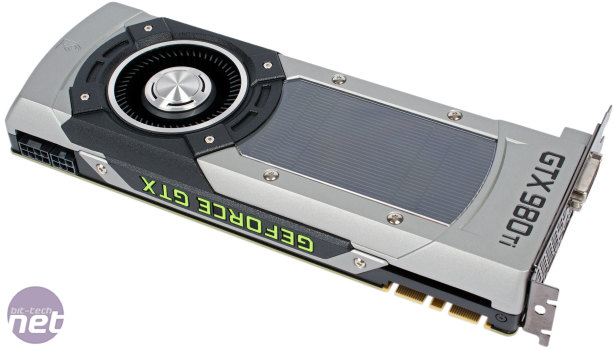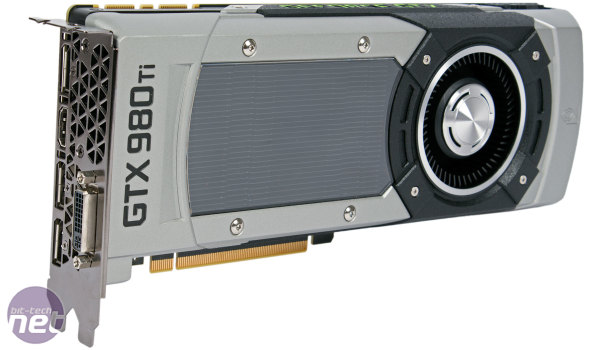
Performance Analysis
Battlefield 4 immediately reveals just how close to Titan X the performance is; from 1080p up to 4K there's only ever a 1-2fps difference on minimum frame rates and 2-3fps on average ones. It's a particularly strong result at 4K, where it is 10fps quicker than the R9 290X. This might not sound like a lot, but a 39fps minimum is distinctively less choppy than 29fps, especially if you're also using a G-Sync panel. Naturally, the R9 295X2 is faster, as it is in all of the games tests, but then it is using two GPUs rather than one.In BioShock, there's again very little difference between this new card and Titan X and the GTX 980 Ti sails smoothly through every resolution, netting a minimum of almost 100fps 1440p – it's certainly not messing around. It is again significantly faster than the R9 290X, and even the dual GPU R9 295X2 is not that far ahead.
Crysis 3 is our most punishing title, but the GTX 980 Ti is still never more than 4fps behind Titan X. It's easily playable at 1440p, though it can't push past a 60fps minimum like the R9 295X2. It even manages above 25fps at 4K, where it's practically neck and neck with Titan X, suggesting that memory bandwidth is the limiting factor here.
The new monster is of course totally fine in Skyrim, as you'd expect. It manages a minimum that's well over 60fps at 4K, meaning you've plenty of leeway to install some more challenging and good-looking mods if you still find yourself roaming Windhelm in the evenings.
Across our more demanding games tests (Battlefield, Crysis and BioShock at 1440p and 4K), GTX Titan X is on average only 4 percent quicker than the GTX 980 Ti. In turn, the new card from Nvidia maintains a lead of 29 percent over the GTX 780 and 50 percent on the R9 290X.
In Unigine Valley, the GTX 980 Ti and Titan X are level at 1080p, though the latter card pulls ahead with a 6 percent lead at 1440p. In the same tests, it is 20 percent and 30 percent quicker than the GTX 980 respectively.
Power consumption is on par with the other GeForce cards that share its power envelope, including the GTX Titan X, as well as the previous generation GTX 780, GTX 780 Ti and GTX Titan Black. Temperatures are also pretty much level with these cards as well, with Nvidia's default fan curve tuned to not let the card go above 83°C, or a delta T of about 60°C. The power and temperature figures are still below those of the reference R9 290X, and though the card is clearly audible it's not distractingly loud – fans span up to 51 percent under load, or just under 2,500 RPM.
On average, performance increased by between 18 and 22 percent as a result of our overclocks, with a particularly strong result in Crysis 3. It easily surpasses reference GTX Titan X performance, and comparing the two when they're both overclocked shows virtually no difference – the minimum frame rate in Crysis 3 and Battlefield is identical and there's just 38 points between them in Unigine Valley. Power consumption rose by a reasonable 50W for the added performance, and the fans became a touch louder in order to keep the temperature the same, spinning at 54 percent, approximately 2,600 RPM.
Conclusion
The GTX 780 Ti dethroned the original Titan in gaming performance, and while the GTX 980 Ti doesn't quite do that to the Titan X, it does make it an even more irrelevant card now. The performance in games is so close, and it's a gap that can easily be closed and even overcome with some very basic overclocking. Without its compute credentials, the only thing Titan X really holds over the GTX 980 Ti is the extra 6GB of memory – something that's nice to have, but not worth almost £300. The fact is that many third party GTX 980 Ti cards will outperform Titan X for significantly less cash – it will be interesting to see if any GTX 980 Ti 12GB cards are released.It's also interesting that the GTX 980 Ti is priced much closer to the GTX 980 than the Titan X, despite having much more in common with the latter in terms of performance. It seems Nvidia is keeping Titan X as the card for those who can only ever have the best and deliberately removing it from the price-performance curve. GTX 980 Ti is still expensive, but with a GTX 980 ready to set you back at least £420, the new offering from Nvidia is just over 30 percent more expensive, and is roughly that much more quicker too. Until AMD shakes up the high end, it's hard to get fairer than that.
In fact, when it comes to AMD, it's currently hard to say anything too meaningful as the GTX 980 Ti is in a different league to any single GPU card currently offered by the red team, and the R9 295X2 stocks seems to be dwindling very fast too. With the R9 390X expected by the end of June, there's little reason to part with your cash right now if you're shopping for a high-end GPU. This is clearly an awesome card, but nonetheless our advice is to take note of the various GTX 980 Ti cards that come out and then see what AMD brings to the table before making your choice.

-
Performance39 / 40
-
Features27 / 30
-
Value20 / 30


MSI MPG Velox 100R Chassis Review
October 14 2021 | 15:04











Want to comment? Please log in.